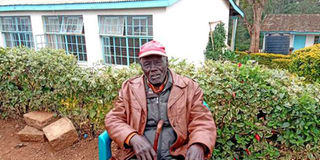Mau Mau screening camp turned into farmers’ school

Mzee Njuguna Karanja sits behind the screening chamber at Kenyatta Farmers Training Centre where colonialists tortured him to establish whether he had taken the oath of allegiance to the Mau Mau movement. PHOTO | NDUNGU GACHANE | NATION MEDIA GROUP
What you need to know:
The grey were those who admitted to having taken the Mau Mau oath. They were detained in camps in central Kenya for supervision and were later given State jobs such as home guards.
The white were those who denied taking the oath. They were reintegrated into the community, while the black were those considered to be deeply involved in Mau Mau activities.
Kenyatta Farmers Training Centre, also known as Mariira Farm, has morphed from a camp where colonialists screened natives to establish if they were members of the outlawed Mau Mau movement to an agricultural centre.
The farm, located in Kigumo sub-county Murang’a County, started as an independent school sponsored by the African Independent Pentecostal Church of Africa in the early 1940s.
Mau Mau fighters also used it to administer oaths to recruits in the 1952 to 1960 uprising against colonial rule.
TORTURED
At the height of the Mau Mau uprising and the subsequent state of emergency, colonialists ordered closure of all independent schools and made Mariira a screening camp for locals.
The screening involved torture to establish if they were members of the Mau Mau movement that the colonialists had outlawed.
Mzee Njuguna Karanja, 85, one of the people who were screened at Mariira, remembers how he was tortured to extract information on his allegiance to Mau Mau. The interrogation room — a screening-cum-torture chamber — still stands at the farm.
Mzee Karanja says some people died during the interrogation.
Colonists, he recalls, classified local people into three groups: the grey, the white and the black.
The grey were those who admitted to having taken the Mau Mau oath. They were detained in camps in central Kenya for supervision and were later given State jobs such as home guards.
DETENTION
The white were those who denied taking the oath. They were reintegrated into the community, while the black were those considered to be deeply involved in Mau Mau activities. The group was considered to be leaders of the revolt, either as oath administrators or guerrilla fighters.
They were sent to far away detention camps such as Manyani, Hola, and Manda Island in Lamu.
A filing of a colonial district officer reads: “The under mentioned Mau Mau convict is due for release on September 29, 1955. He was convicted of the offence of being a member of an unlawful society to three years imprisonment with hard labour, the Commissioner of Prisons recommends black detention.”
Mzee Karanja said that after witnessing how his age-mates died after torture at the Mariira screening camp and after the immense torture meted out on him by the home guards who screened him on behalf of the administration, he admitted that he had taken the Mau Mau oath in the hope of being released.
DISABLED
He was freed, but secretly continued helping Mau Mau fighters, he said. He took them food in the forest.
The octogenarian agreed to accompany us to Mariira farm, but would not enter the screening room.
He instead cried uncontrollably as he recalled the atrocities meted out on his age mates.
“I’ve difficulty walking. I was tortured to the appoint of agreeing that I’d taken an oath. The screening camp was hell. Many like me became disabled after the torture,” he said.
The 18-by-15-foot screening chamber is now used as a store.
PRACTICES
Three kilometres from the screening camp is Kigumo Youth Polytechnic, which colonialists used as a prison.
It was adjacent to colonial offices and the living quarters of administrators. After Kenya attained independence on December 12, 1963, the screening camp was turned into Kenyatta Farmers Institute.
The farm was also made the headquarters of Murang’a South District and later became Kenyatta Farmers Training Centre.
Mr Peter Muchiri, the principal of the institute, said that farmers come from different parts of the country to learn best farming practices.
GAZETTING
Farmers are trained on dairy and fish farming, among other subjects. The farm has a dam, a demonstration centre, and eight acres of tea. It “has been a source of knowledge for farmers across the country despite its history. Many people have acquired agricultural skills and have become better agri-entrepreneurs,” Mr Muchiri says.
Mr Antony Maina, a National Museums of Kenya representative, said plans were underway to gazette the farm and the polytechnic as historical sites.
“We have visited the area and are in the final phase of gazetting the farm, the polytechnic and buildings which acted as living quarters of the colonial administrative officers,” Mr Maina said.
Is there a site you want us to feature? Write an e-mail to [email protected]




